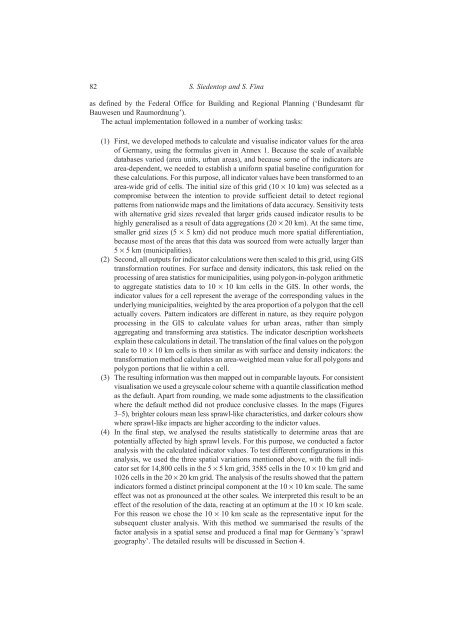PDF 20.134kB - TOBIAS-lib - Universität Tübingen
PDF 20.134kB - TOBIAS-lib - Universität Tübingen
PDF 20.134kB - TOBIAS-lib - Universität Tübingen
Erfolgreiche ePaper selbst erstellen
Machen Sie aus Ihren PDF Publikationen ein blätterbares Flipbook mit unserer einzigartigen Google optimierten e-Paper Software.
82 S. Siedentop and S. Fina<br />
as defined by the Federal Office for Building and Regional Planning (‘Bundesamt für<br />
Bauwesen und Raumordnung’).<br />
The actual implementation followed in a number of working tasks:<br />
(1) First, we developed methods to calculate and visualise indicator values for the area<br />
of Germany, using the formulas given in Annex 1. Because the scale of available<br />
databases varied (area units, urban areas), and because some of the indicators are<br />
area-dependent, we needed to establish a uniform spatial baseline configuration for<br />
these calculations. For this purpose, all indicator values have been transformed to an<br />
area-wide grid of cells. The initial size of this grid (10 · 10 km) was selected as a<br />
compromise between the intention to provide sufficient detail to detect regional<br />
patterns from nationwide maps and the limitations of data accuracy. Sensitivity tests<br />
with alternative grid sizes revealed that larger grids caused indicator results to be<br />
highly generalised as a result of data aggregations (20 · 20 km). At the same time,<br />
smaller grid sizes (5 · 5 km) did not produce much more spatial differentiation,<br />
because most of the areas that this data was sourced from were actually larger than<br />
5 · 5 km (municipalities).<br />
(2) Second, all outputs for indicator calculations were then scaled to this grid, using GIS<br />
transformation routines. For surface and density indicators, this task relied on the<br />
processing of area statistics for municipalities, using polygon-in-polygon arithmetic<br />
to aggregate statistics data to 10 · 10 km cells in the GIS. In other words, the<br />
indicator values for a cell represent the average of the corresponding values in the<br />
underlying municipalities, weighted by the area proportion of a polygon that the cell<br />
actually covers. Pattern indicators are different in nature, as they require polygon<br />
processing in the GIS to calculate values for urban areas, rather than simply<br />
aggregating and transforming area statistics. The indicator description worksheets<br />
explain these calculations in detail. The translation of the final values on the polygon<br />
scale to 10 · 10 km cells is then similar as with surface and density indicators: the<br />
transformation method calculates an area-weighted mean value for all polygons and<br />
polygon portions that lie within a cell.<br />
(3) The resulting information was then mapped out in comparable layouts. For consistent<br />
visualisation we used a greyscale colour scheme with a quantile classification method<br />
as the default. Apart from rounding, we made some adjustments to the classification<br />
where the default method did not produce conclusive classes. In the maps (Figures<br />
3–5), brighter colours mean less sprawl-like characteristics, and darker colours show<br />
where sprawl-like impacts are higher according to the indictor values.<br />
(4) In the final step, we analysed the results statistically to determine areas that are<br />
potentially affected by high sprawl levels. For this purpose, we conducted a factor<br />
analysis with the calculated indicator values. To test different configurations in this<br />
analysis, we used the three spatial variations mentioned above, with the full indicator<br />
set for 14,800 cells in the 5 · 5 km grid, 3585 cells in the 10 · 10 km grid and<br />
1026 cells in the 20 · 20 km grid. The analysis of the results showed that the pattern<br />
indicators formed a distinct principal component at the 10 · 10 km scale. The same<br />
effect was not as pronounced at the other scales. We interpreted this result to be an<br />
effect of the resolution of the data, reacting at an optimum at the 10 · 10 km scale.<br />
For this reason we chose the 10 · 10 km scale as the representative input for the<br />
subsequent cluster analysis. With this method we summarised the results of the<br />
factor analysis in a spatial sense and produced a final map for Germany’s ‘sprawl<br />
geography’. The detailed results will be discussed in Section 4.

















